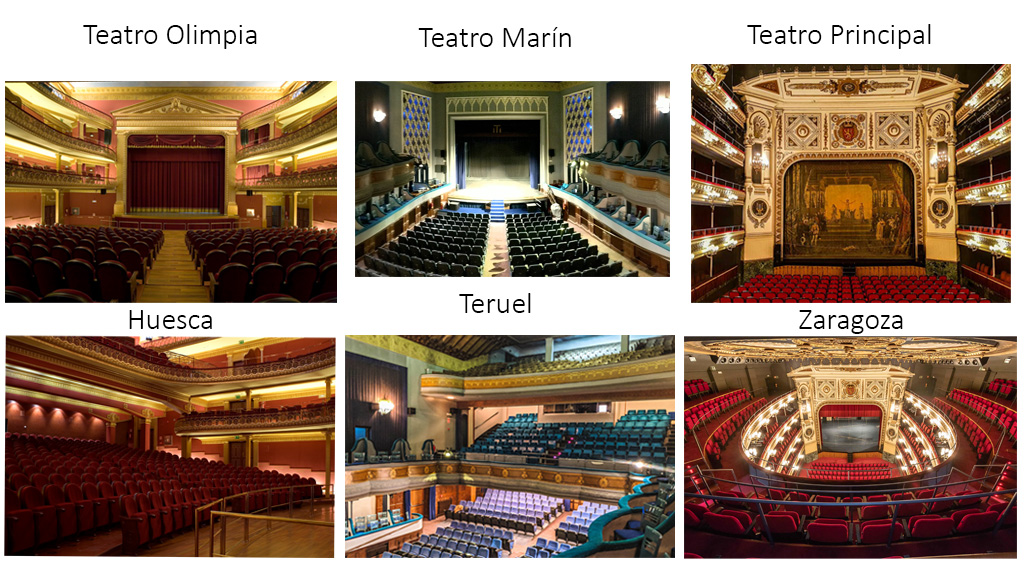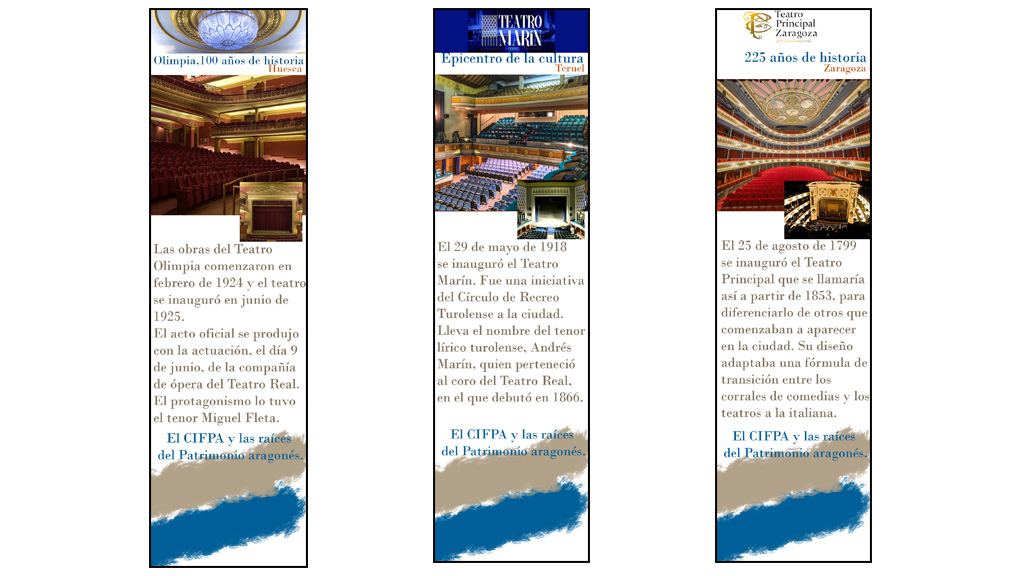
11 Jul Centenary Aragonese theaters, cultural epicenters
The main theaters of the Aragonese community are celebrating. In 2024, the Teatro Principal in Zaragoza will be 225 years old. For its part, the Teatro Olimpia in Huesca celebrates its first 100 years in 2025. Nor can we forget the Teatro Marín in Teruel, which is already over 106 years old.
The three theaters located in the capitals of the three Aragonese provinces are the epicenter of culture and a meeting point for citizens who have been able and can enjoy companies, groups and artists of national and international renown.
Principal Theater of Zaragoza
The Principal Theater of Zaragoza has 225 years of existence. It was inaugurated on August 25, 1799 and has had its current name since 1853. The project was launched after the devastating fire, on the afternoon of November 12, 1778, of the Coliseum of comedies of Zaragoza, located on the site now occupied by the Bank of Spain.
Its design, with a capacity for 1,600 spectators, adapted a transition formula between the corrales de comedias and Italian-style theaters. The stage and the U-shaped hall occupied the entire lot with hardly any secondary spaces.
Throughout its more than two centuries of existence, this great theater has undergone several interventions for its consolidation, expansion and maintenance. Prominent architects such as Ricardo Magdalena, Regino Borobio, José Beltrán and José Manuel Pérez Latorre have left their mark, but despite all the interventions, it can be said that the original structure of 1799 remains identical as far as the auditorium is concerned. At present, the Teatro Principal of Zaragoza has a seating capacity of 834 seats.
Olimpia Theater of Huesca
In 1923, the Huesca businessman Antonio Pié presented the project of what was to be the future Olympia Theater. This document was signed by the Huesca architects Bruno Farina and Enrique Vicenti, although it seems that the real author of the plans was Colonel Agustín Loscertales, an engineer and not an architect, so he could not sign the project.
The final result was different from the project, as can be seen today. Inside, the layout of the boxes and the stalls was altered to achieve a larger capacity, so two new levels were created, in the form of continuous boxes, one between the stalls and the amphitheater, and the other above the amphitheater.
The interior decoration is eclectic, mixing baroque elements in the parapets, classical elements in the mouth and around the room, with a series of figures in the four corners of the theater, which responds to the postulates of art deco, which began to be in vogue in those years. The entrance of the theater is also decorated with classical elements, topped with a pediment supported by two pilasters, in direct relation to the facade.
The façade finally has six columns instead of the eight planned, and the pediment was decorated with the figures of Glory and Fortune holding the coat of arms of the city, the work of the sculptor Torre Clavero. Work began in February 1924 and the theater was inaugurated in June 1925.
Marín Theater of Teruel
The Circulo de Recreo Turolense "El Casino" built in 1918 the Marín Theater of Teruel. The reason this entity took the initiative was its conviction that the city should host cultural and artistic events to become the cultural epicenter of the province.
The Tarragona architect Pablo Monguió y Segura drew up the theater project that would be inaugurated on May 29, 1918.
Monguió from February 13, 1898 to February 27, 1902 was architect of the common of Teruel. Professional clashes with the City Council over the collapse of the Arrabal schools forced his resignation, but he returned in 1908 when he obtained the position of provincial architect of Teruel, which lasted until he joined the corps of architects of the Ministry of Finance on May 14, 1919.
His most outstanding buildings were erected in Teruel and Tortosa and his preference for the modernist style inspired by the architecture of Lluís Domènec i Montaner was reflected in the Marín Theater and other buildings in the city.
The name "Marín" is due to the tenor Andrés Marín who was born in the city of lovers and belonged to the chorus of the Teatro Real, where he made his debut in 1866. He performed on the best stages in the world.


